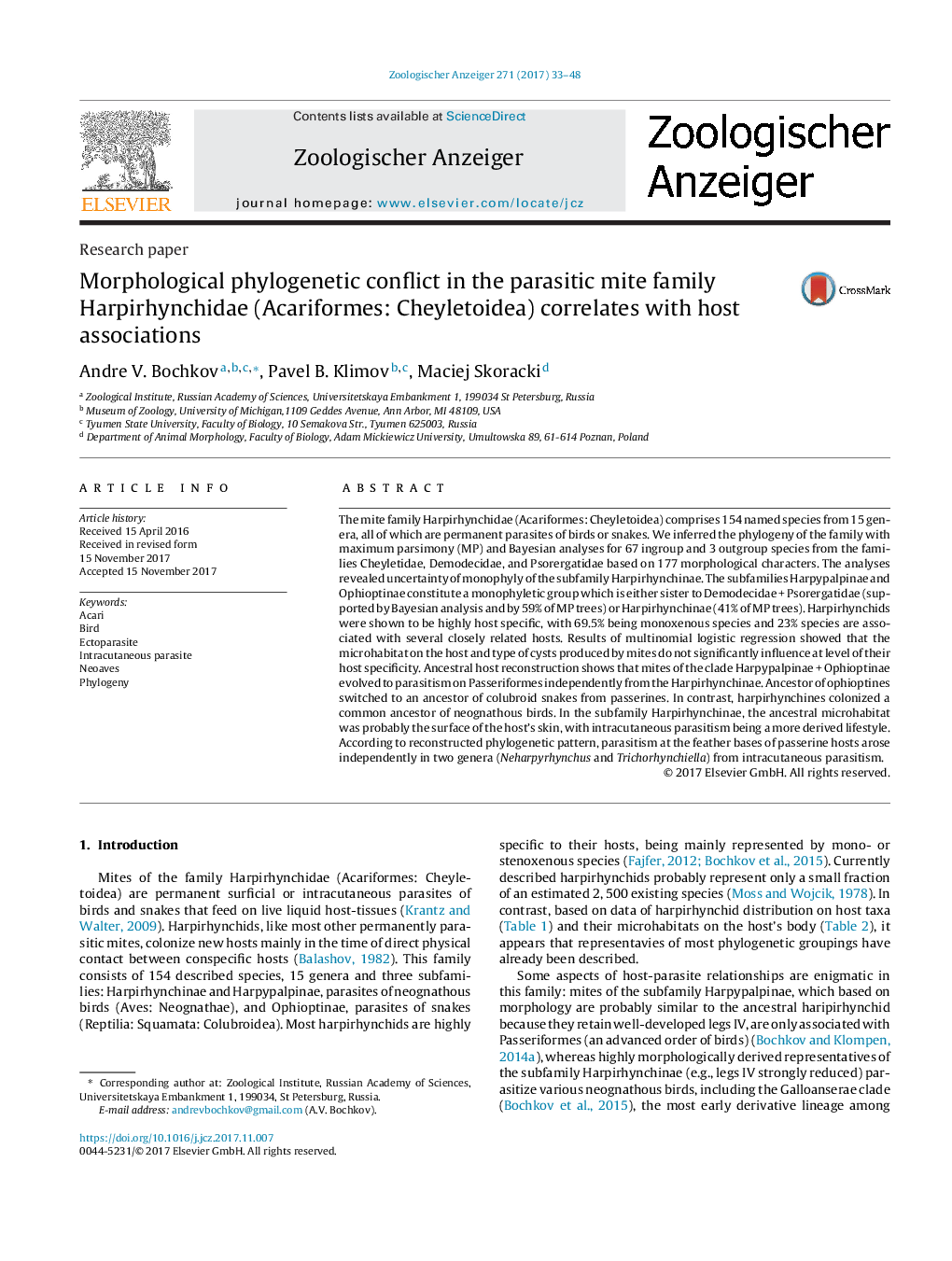| کد مقاله | کد نشریه | سال انتشار | مقاله انگلیسی | نسخه تمام متن |
|---|---|---|---|---|
| 8626888 | 1568604 | 2017 | 16 صفحه PDF | دانلود رایگان |
عنوان انگلیسی مقاله ISI
Morphological phylogenetic conflict in the parasitic mite family Harpirhynchidae (Acariformes: Cheyletoidea) correlates with host associations
دانلود مقاله + سفارش ترجمه
دانلود مقاله ISI انگلیسی
رایگان برای ایرانیان
موضوعات مرتبط
علوم زیستی و بیوفناوری
علوم کشاورزی و بیولوژیک
علوم دامی و جانورشناسی
پیش نمایش صفحه اول مقاله

چکیده انگلیسی
The mite family Harpirhynchidae (Acariformes: Cheyletoidea) comprises 154 named species from 15 genera, all of which are permanent parasites of birds or snakes. We inferred the phylogeny of the family with maximum parsimony (MP) and Bayesian analyses for 67 ingroup and 3 outgroup species from the families Cheyletidae, Demodecidae, and Psorergatidae based on 177 morphological characters. The analyses revealed uncertainty of monophyly of the subfamily Harpirhynchinae. The subfamilies Harpypalpinae and Ophioptinae constitute a monophyletic group which is either sister to Demodecidae + Psorergatidae (supported by Bayesian analysis and by 59% of MP trees) or Harpirhynchinae (41% of MP trees). Harpirhynchids were shown to be highly host specific, with 69.5% being monoxenous species and 23% species are associated with several closely related hosts. Results of multinomial logistic regression showed that the microhabitat on the host and type of cysts produced by mites do not significantly influence at level of their host specificity. Ancestral host reconstruction shows that mites of the clade Harpypalpinae + Ophioptinae evolved to parasitism on Passeriformes independently from the Harpirhynchinae. Ancestor of ophioptines switched to an ancestor of colubroid snakes from passerines. In contrast, harpirhynchines colonized a common ancestor of neognathous birds. In the subfamily Harpirhynchinae, the ancestral microhabitat was probably the surface of the host's skin, with intracutaneous parasitism being a more derived lifestyle. According to reconstructed phylogenetic pattern, parasitism at the feather bases of passerine hosts arose independently in two genera (Neharpyrhynchus and Trichorhynchiella) from intracutaneous parasitism.
ناشر
Database: Elsevier - ScienceDirect (ساینس دایرکت)
Journal: Zoologischer Anzeiger - A Journal of Comparative Zoology - Volume 271, November 2017, Pages 33-48
Journal: Zoologischer Anzeiger - A Journal of Comparative Zoology - Volume 271, November 2017, Pages 33-48
نویسندگان
Andre V. Bochkov, Pavel B. Klimov, Maciej Skoracki,